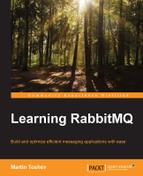In this chapter, we saw how to create a cluster of RabbitMQ nodes for the purpose of scaling out our broker. We saw how this allowed for the even distribution of queues on different nodes in the cluster, thus increasing storage capacity and performance in the cluster. We discussed what DISK and RAM nodes are and how they can be added and removed from a cluster; we also demonstrated how to connect to the cluster from a Java publisher/subscriber client and how a cluster tolerates failure on some of the nodes. Finally, we further extended the CSN with multiple RabbitMQ instances, forming a RabbitMQ cluster. The clustering mechanism supported by RabbitMQ has some drawbacks such as, for example, the lack of support for establishing high availability as a means of making image processing more reliable.
